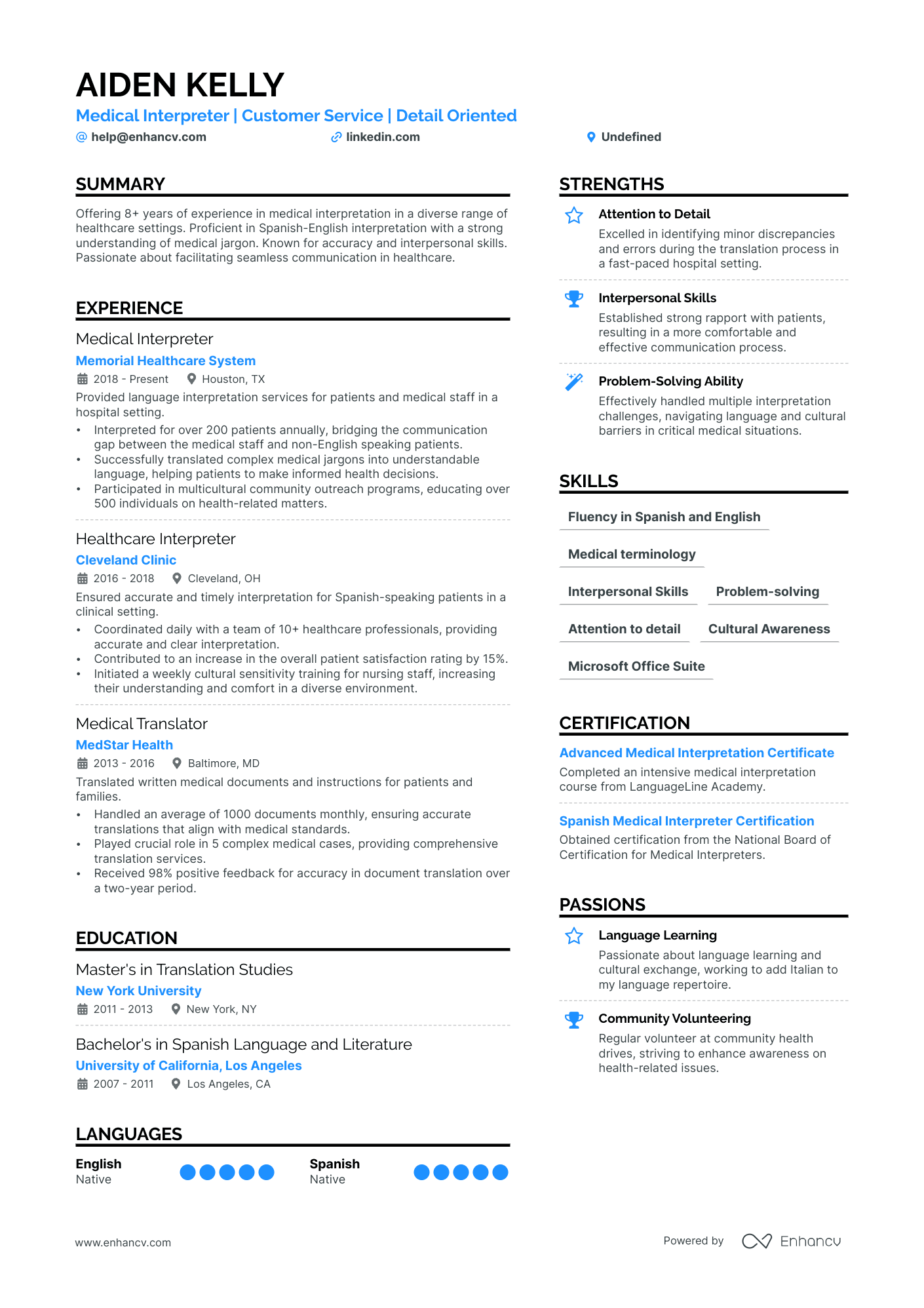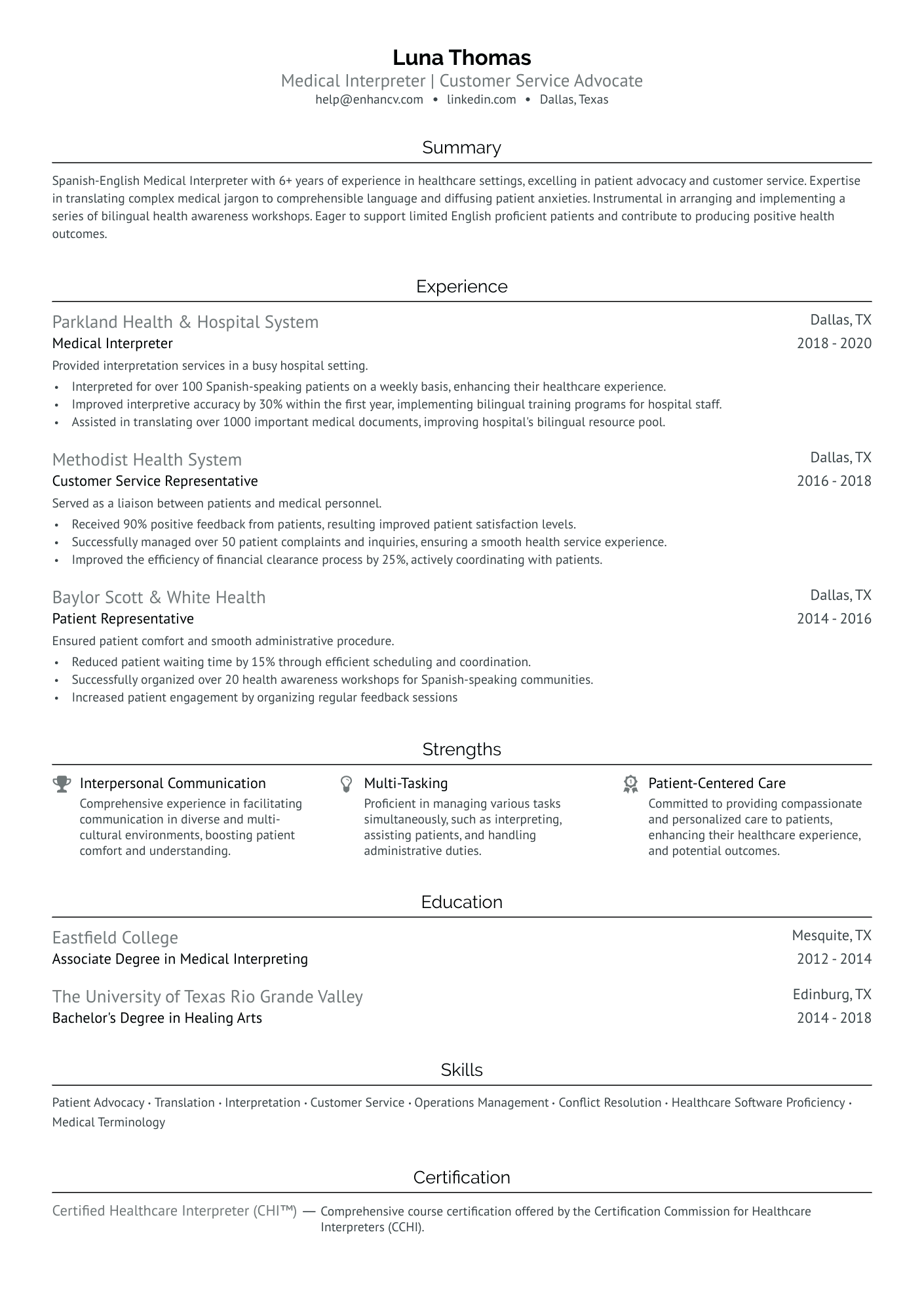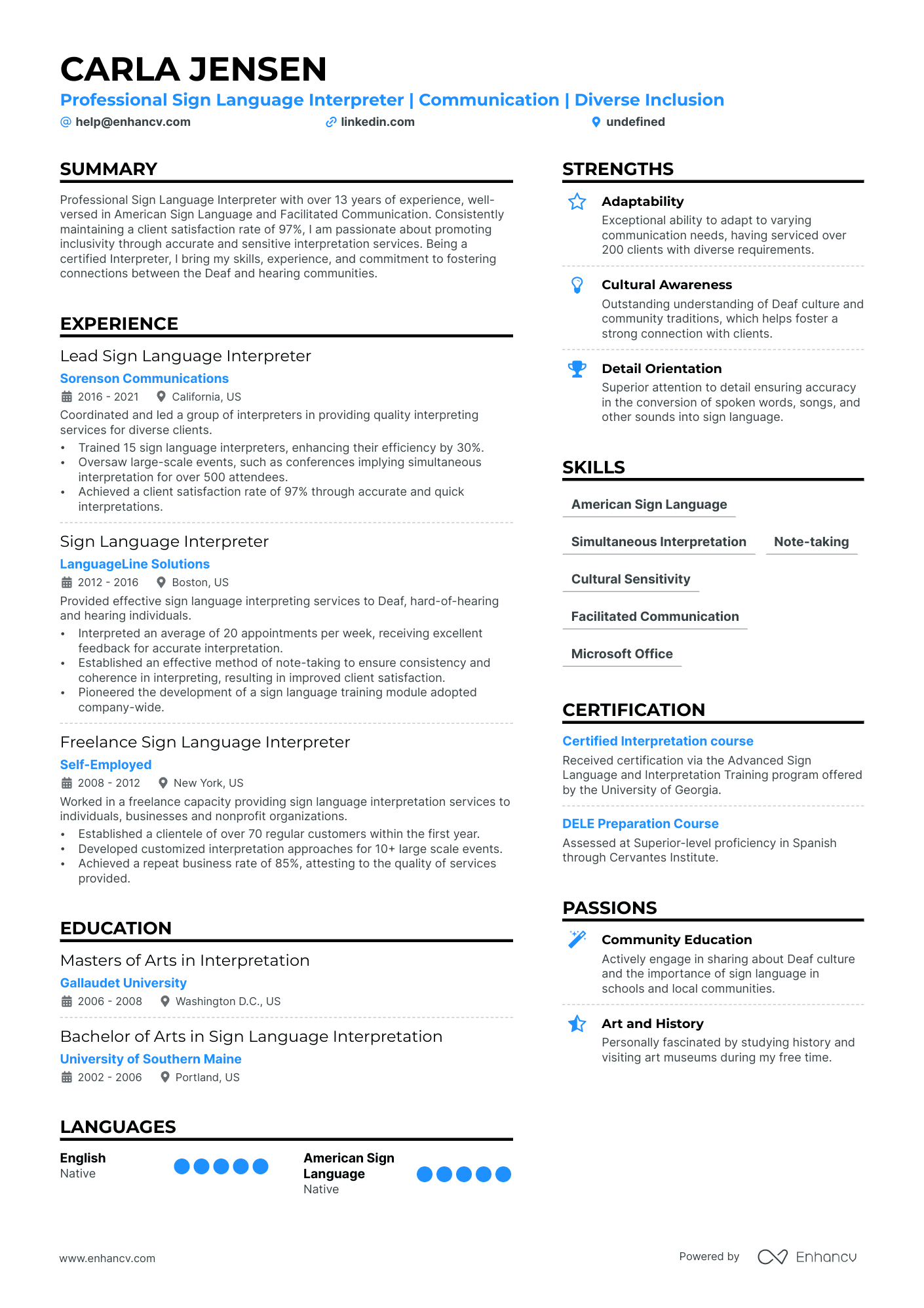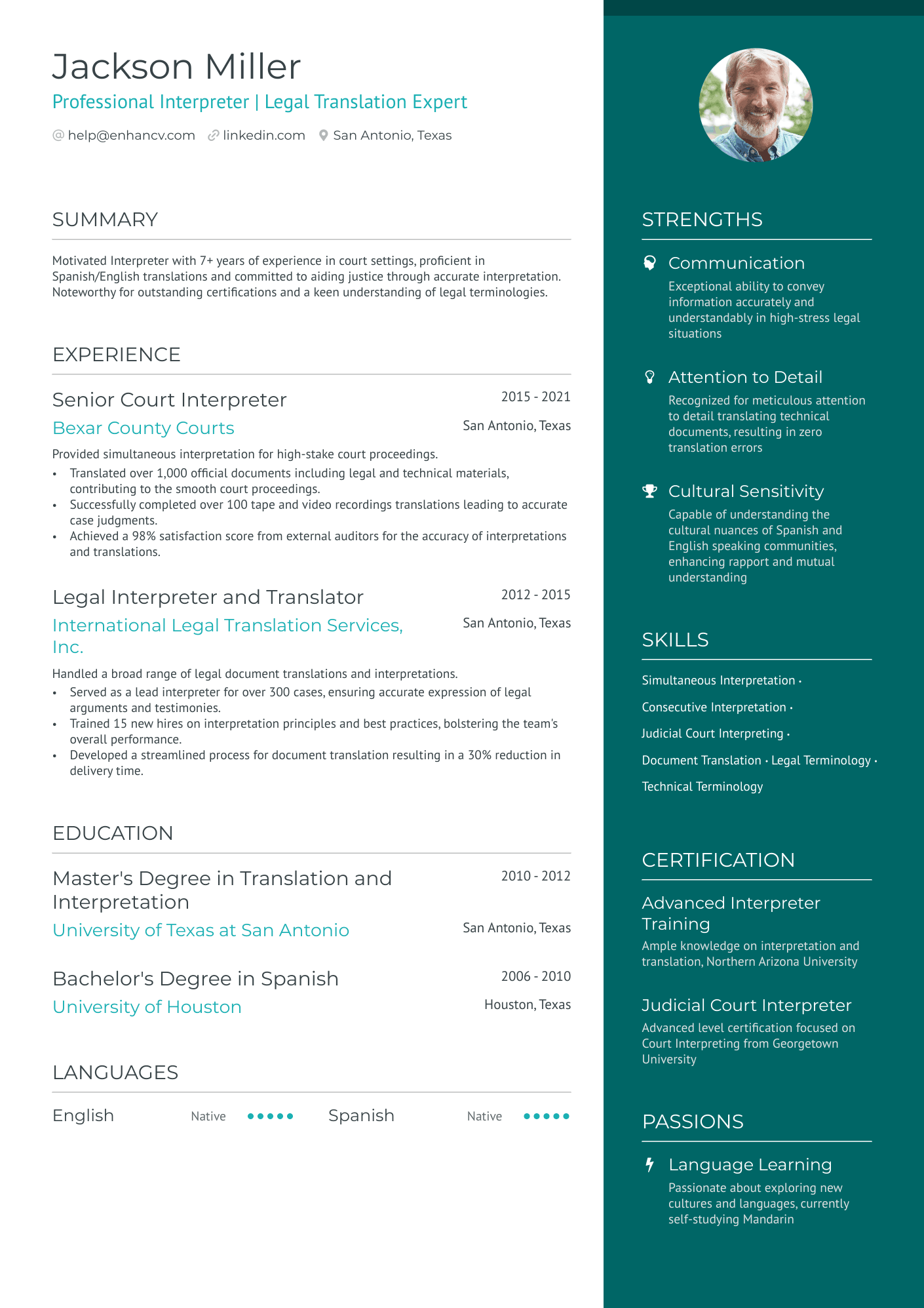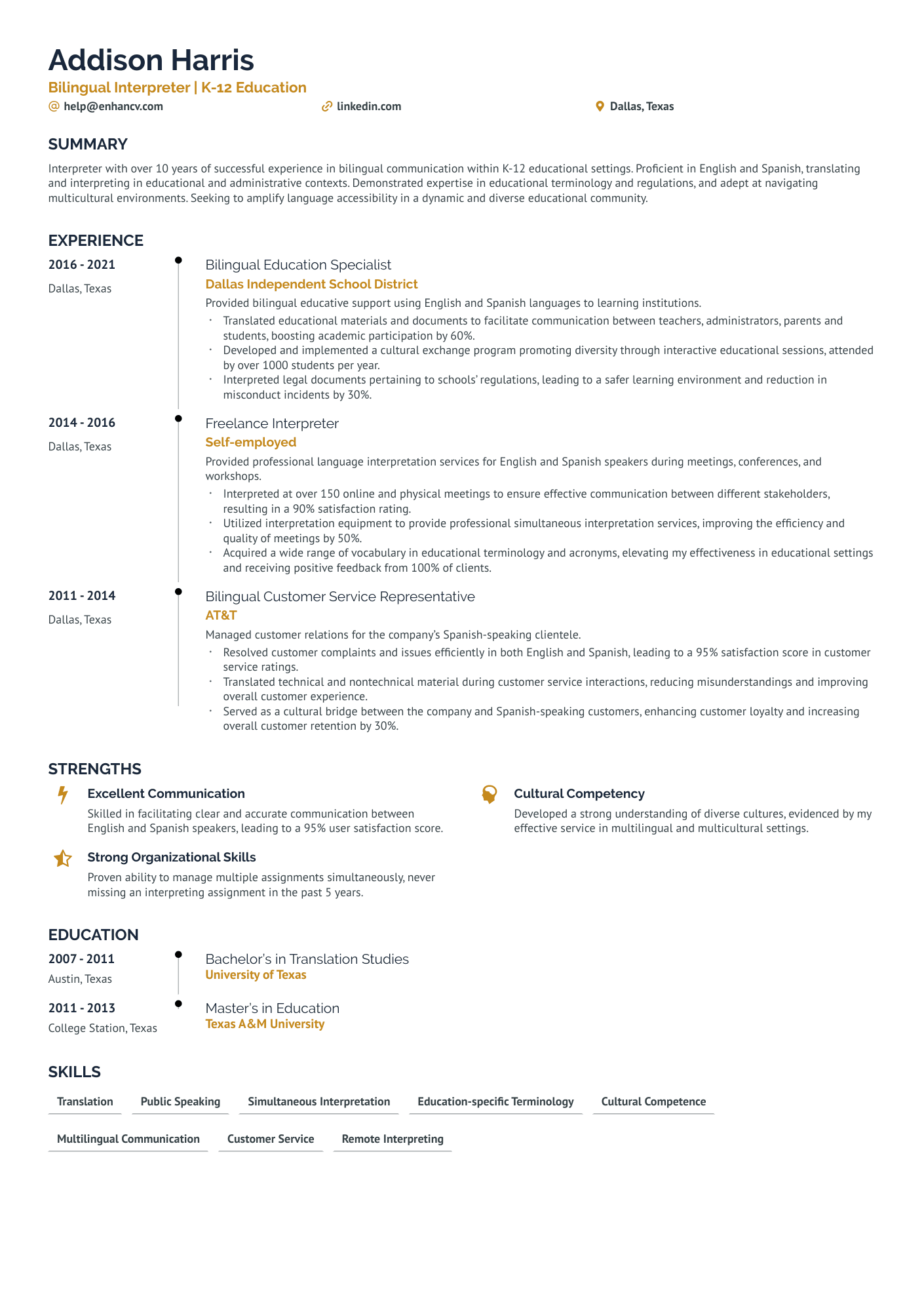As an interpreter, effectively showcasing your language proficiency and diverse cultural experiences on your resume can be a challenge. Our guide offers tailored strategies to help you highlight your linguistic skills and cross-cultural insights, ensuring that your resume stands out to potential employers.
- Apply best practices from professional resumes to spotlight your application;
- Quantify your professional experience with achievements, career highlights, projects, and more;
- Write an eye-catching interpreter resume top one-third with your header, summary/objective, and skills section;
- Fill in the gaps of your experience with extracurricular, education, and more vital resume sections.
We've selected, especially for you, some of our most relevant interpreter resume guides. Getting you from thinking about your next career move to landing your dream job.
- Chiropractic Office Manager Resume Example
- Assistant Front Office Manager Resume Example
- Front Desk Supervisor Resume Example
- Office Administrator Resume Example
- Sales Administrative Assistant Resume Example
- School Administrative Assistant Resume Example
- Administrative Manager Resume Example
- Front Desk Manager Resume Example
- HR Administrative Assistant Resume Example
- Dental Office Manager Resume Example
Optimize your interpreter resume format to pass the recruiters' assessment
You may be wondering just how much time you need to spend on designing your interpreter resume.What recruiters are looking for is systematised content that is clear and coherent. Thus, your interpreter resume needs to answer requirements and why you're the best candidate for the role from the get-go.
Often, a clear layout consists of:
- Sorting your experience in the reverse chronological order - starting with your most recent and relevant roles. This is an excellent choice for more experienced professionals;
- Writing your contact information (e.g. personal phone number and email address) and your portfolio or LinkedIn link in your interpreter resume header. If you're wondering to include a photo or not, always make sure that it's appropriate for the country you're applying in;
- Use the basic, most important interpreter resume sections - your experience, education, summary, etc. Use your resume's real estate wisely to tell a compelling, professional story and match job description's keywords;
- Don't go overboard with the length of your resume. One page is absolutely fine if you happen to have under a decade of relevant experience.
Are you still wondering if you should submit your interpreter resume in PDF or Word format ? The PDF has a few more advantages, as it doesn't change the format and the text can't be altered upon application.
Format matters most when your interpreter resume is assessed by the Applicant Tracker System (or the ATS).
The ATS parses resumes, looking for specific keywords, skills or experience that match the job description.
P.S. We recently did a study on how the ATS works and were able to demystify three of the biggest misconceptions about how it assesses candidate resumes.
To pass the ATS evaluation, select any of the serif or sans-serif fonts. Popular choices that would help your interpreter resume stand out include Raleway, Exo 2, Montserrat, etc.
Most traditionalists go for Arial or Times New Roman, but it's often the case that many candidates choose these fonts, and you'd thus lose points on the uniqueness front.
Upload & Check Your Resume
Drop your resume here or choose a file. PDF & DOCX only. Max 2MB file size.
PRO TIP
If the certificate you've obtained is especially vital for the industry or company, include it as part of your name within the resume headline.
Don't forget to include these six sections on your interpreter resume:
- Header and summary for your contact details and to highlight your alignment with the interpreter job you're applying for
- Experience section to get into specific technologies you're apt at using and personal skills to deliver successful results
- Skills section to further highlight how your profile matches the job requirements
- Education section to provide your academic background
- Achievements to mention any career highlights that may be impressive, or that you might have missed so far in other resume sections
What recruiters want to see on your resume:
- Language proficiency in both the source and target languages
- Experience with interpreting in specific settings such as legal, medical, or conference environments
- Certifications or memberships in professional interpreter organizations
- Ability to handle culturally sensitive or specialized terminology accurately
- Soft skills such as strong listening abilities, clear enunciation, and quick, accurate thinking
Five dos for building your interpreter resume experience section
The best strategic approach to your interpreter resume experience section is to support your particular responsibilities with actions and achievements.
For example, you could list:
- Up to six responsibilities in your day-to-day work, supported by why they're important for your role, department, or organization;
- Experience items that have helped you sustain and enhance your technical knowledge within the field, or, perhaps, have helped you grow as a professional;
- Any metrics that pinpoint your success within your past roles;
- How you've solved specific problems in your day-to-day work;
- Strategies and solutions you've implemented for growth - and how that growth was measured.
The interpreter resume experience is your best shot at making a good first impression on recruiters. That's why we've included some real-world professional examples to get you thinking about how you present your experience:
- Provided simultaneous interpretation services for high-level international conferences, translating over 500 hours of speeches from Spanish to English.
- Enhanced communication between English-speaking CEOs and French partners, leading to a 25% increase in successful joint ventures.
- Developed customized glossaries and translation materials for specific industry terms in legal and medical fields, improving accuracy and reducing miscommunication incidents by 40%.
- Facilitated successful contract negotiations in Mandarin Chinese for a tech firm, resulting in a landmark deal worth $10 million with a key Asian supplier.
- Advised and trained junior interpreters, enhancing the team's overall productivity and quality of interpretation at international trade shows.
- Integrated new digital interpretation tools, such as CAT (Computer Assisted Translation) software, to streamline workflow and improve service delivery times by 30%.
- Coordinated a team of interpreters during a large-scale international humanitarian crisis, ensuring the effective delivery of crucial information to affected populations.
- Translated over 3000 pages of documentation from Russian to English for governmental environmental impact studies, enhancing transparency and international cooperation.
- Conducted cultural sensitivity trainings for expatriates, fostering better engagement and understanding between local communities and foreign entities.
- Delivered consecutive interpretation for legal depositions, aiding lawyers in winning key cases through clear and accurate translation of witness statements from Arabic to English.
- Served as the chief interpreter during the setup of a multinational corporation's subsidiary in Dubai, which contributed to a 15% growth in the Middle Eastern market for the company.
- Created and managed a repository of translated technical terminology specific to engineering and construction industries, which became a valuable reference tool for peers.
- Specialized in sign language interpreting for deaf and hard-of-hearing individuals in educational settings, ensuring equal access to information and resources.
- Collaborated with instructional designers to create accessible multimedia content with captions and sign language interpretation, increasing course completion rates by 20%.
- Advocated for the adoption of ADA-compliant interpretation practices, significantly reducing the institution's legal compliance risks.
- Functioned as an on-call medical interpreter at various hospitals, accurately conveying critical information between patients and healthcare providers, improving patient satisfaction scores by 15%.
- Developed a comprehensive medical terminology guide in three languages (Portuguese, Spanish, English), which was adopted hospital-wide and reduced interpretation errors.
- Acted as a cultural liaison in complex cases involving multicultural backgrounds, leading to more personalized patient care and better health outcomes.
- Orchestrated a team of community interpreters to support local government outreach programs to non-English speaking residents, increasing community engagement by 35%.
- Initiated a quality assurance program for interpretation services, which included peer reviews and customer feedback mechanisms, reducing error rates by 25%.
- Promoted cross-cultural communication techniques during public forums and workshops, aiding in the prevention of misunderstandings and enhancing local law enforcement's rapport with diverse groups.
- Performed real-time translation of complex cybersecurity material to assist in multinational collaboration efforts for digital security projects, contributing to a safer cyber environment.
- Pioneered the use of secure and encrypted video remote interpreting (VRI) technology to facilitate confidential meetings, leading to a 10% client base increase in the tech industry.
- Regularly updated interpreting proficiency in emerging tech jargon and topics, ensuring accurate and relevant translations for industry-specific conferences.
The following content includes information from "O*NET OnLine" by the U.S. Department of Labor, Employment and Training Administration (USDOL/ETA). Used under the CC BY 4.0 license. The data represents the top responsibilities present on the task lists for interpreter professionals.
Top Responsibilities for Interpreter:
- Translate messages simultaneously or consecutively into specified languages, orally or by using hand signs, maintaining message content, context, and style as much as possible.
- Listen to speakers' statements to determine meanings and to prepare translations, using electronic listening systems as necessary.
- Compile terminology and information to be used in translations, including technical terms such as those for legal or medical material.
- Refer to reference materials, such as dictionaries, lexicons, encyclopedias, and computerized terminology banks, as needed to ensure translation accuracy.
- Check translations of technical terms and terminology to ensure that they are accurate and remain consistent throughout translation revisions.
- Identify and resolve conflicts related to the meanings of words, concepts, practices, or behaviors.
- Compile information on content and context of information to be translated and on intended audience.
- Adapt translations to students' cognitive and grade levels, collaborating with educational team members as necessary.
- Check original texts or confer with authors to ensure that translations retain the content, meaning, and feeling of the original material.
- Adapt software and accompanying technical documents to another language and culture.
Quantifying impact on your resume
- Specify the number of languages you are proficient in and your level of fluency to demonstrate linguistic versatility.
- Include the volume of translation work completed, such as the number of pages or words, to show experience and capability.
- List the number of interpreting sessions or projects you've conducted to highlight your practical experience.
- Mention the types of clients or industries you've worked with, quantified by number, to indicate your sector expertise.
- Quantify any improvements in process efficiency or reduced turnaround time in your past roles to showcase productivity gains.
- State any awards or recognitions received, along with the competitive pool size, to stress professional distinction.
- Indicate the range of cultural contexts or countries you have experience working in to emphasize your adaptability.
- Present any relevant education or certifications with the number of course hours or credits to verify your technical qualifications.
Action verbs for your interpreter resume
What can candidates do about their resume, if they have no experience
Job requirements can sometimes be answered by other elements you could make more prominent in your interpreter resume.
Thus, you'd be substituting your lack of experience with your relevant:
- Education with details of skills you've obtained that align with the job
- Internships and short-term jobs that are once more dedicated to putting your expertise in the spotlight
- Skills section answering basic and - potentially - more specific job qualifications
- Strengths or accomplishments to show the unique value you present, even as a candidate with less or no professional experience in the industry.
Recommended reads:
PRO TIP
Mention specific courses or projects that are pertinent to the job you're applying for.
Shining a light on your interpreter hard skills and soft skills
To win recruiters over, you must really have a breadth of skill set presented and supported within your interpreter resume.
On hiring managers' checklists, you'd initially discover hard or technical skills. Those are the technology (and software) that help you perform on the job. Hard skills are easy to quantify via your education, certificates, and on-the-job success.
Another main criterion recruiters are always assessing your interpreter resume on is soft skills. That is your ability to communicate, adapt, and grow in new environments. Soft skills are a bit harder to measure, as they are gained both thanks to your personal and professional experience.
Showcase you have the ideal skill set for the role by:
- Dedicating both a skills box (for your technical capabilities) and an achievements or strengths section (to detail your personal skills).
- When listing your skills, be specific about your hard skills (name the precise technology you're able to use) and soft skills (aim to always demonstrate what the outcomes were).
- Avoid listing overused cliches in the skills section (e.g. Microsoft Office and Communication), unless they're otherwise specified as prominent for the role.
- Select up to ten skills which should be defined via various sections in your resume skills sidebar (e.g. a technical skills box, industry expertise box with sliders, strengths section with bullets).
Spice up your resume with leading technical and people skills, that'd help you get noticed by recruiters.
Top skills for your interpreter resume:
Fluency in multiple languages
Translation software proficiency
Note-taking techniques
Voice modulation techniques
Understanding of cultural nuances
Familiarity with legal terminology
Use of interpretation equipment (e.g., headsets, microphones)
Computer-assisted translation tools
Remote interpretation platforms
Terminology databases
Active listening
Communication skills
Critical thinking
Interpersonal skills
Adaptability
Attention to detail
Problem-solving
Time management
Confidentiality
Empathy
Next, you will find information on the top technologies for interpreter professonals from "O*NET OnLine" by the U.S. Department of Labor, Employment and Training Administration (USDOL/ETA). Used under the CC BY 4.0 license.
Top technologies for Interpreter’s resume:
- Extensible hypertext markup language XHTML
- Hypertext markup language HTML
- Microsoft PowerPoint
- AceTools.biz Ace Translator
- Stormdance CatsCradle
PRO TIP
Listing your relevant degrees or certificates on your interpreter resume is a win-win situation. Not only does it hint at your technical capabilities in the industry, but an array of soft skills, like perseverance, adaptability, and motivation.
The interpreter resume sections you may underestimate: certifications and education
Your education and certifications provide insight into both your technical capabilities and personal attributes, such as perseverance. When crafting your interpreter resume, consider how you present these elements:
- For your higher education degrees, prioritize listing those most relevant to the job or indicative of your academic dedication;
- Include applicable coursework as a stand-in for relevant experience or if it might impress recruiters;
- Include incomplete higher education only if it's pertinent to meeting job requirements;
- If your degree is from a renowned university, mention how often you made the Dean's list to underline academic excellence.
Regarding certifications, it's not necessary to list all of them. Instead, match up to three of your most recent or significant certificates with the technical skills required in the job description.
Below, we've selected some of the top industry certifications that could be vital additions to your interpreter resume.
The top 5 certifications for your interpreter resume:
- Certified interpreter (CI) - Registry of interpreters for the Deaf (RID)
- Nationally Certified interpreter (NCI) - National Association of the Deaf (NAD)
- Certified Medical interpreter (CMI) - National Board of Certification for Medical interpreters (NBCMI)
- Certified Healthcare interpreter (CHI) - Certification Commission for Healthcare interpreters (CCHI)
- Federal Court interpreter Certification (FCIC) - Administrative Office of the United States Courts
The content below includes information from "O*NET OnLine" by the U.S. Department of Labor, Employment and Training Administration (USDOL/ETA). Used under the CC BY 4.0 license. The data represents the top associations for interpreter professionals.
Top US associations for a Interpreter professional
- Alexander Graham Bell Association for the Deaf and Hard of Hearing
- American Association of the DeafBlind
- American Literary Translators Association
- American Sign Language Teachers Association
- American Translators Association
PRO TIP
Showcase any ongoing or recent educational efforts to stay updated in your field.
Recommended reads:
Practical guide to your interpreter resume summary or objective
First off, should you include a summary or objective on your interpreter resume?
We definitely recommend you choose the:
- Resume summary to match job requirements with most noteworthy accomplishments.
- Resume objective as a snapshot of career dreams
Both the resume summary and objective should set expectations for recruiters as to what your career highlights are.
These introductory paragraphs (that are no more than five sentences long) should help you answer why you're the best candidate for the job.
Industry-wide best practices pinpoint that the interpreter resume summaries and objectives follow the structures of these samples:
Resume summaries for a interpreter job
- Dynamic interpreter with 8 years of experience, fluent in Spanish, English, and French, offering advanced proficiency in simultaneous translation. Championed a major international conference, facilitating communication for over 1,000 attendees, showcasing unparalleled linguistic skill and dedication to cross-cultural understanding.
- Dedicated former healthcare professional pivoting to linguistic services with foundational knowledge in medical terminology in German and English. Brings compassionate communication skills refined over 5 years of patient care, aiming to bridge language barriers in healthcare settings to improve patient outcomes.
- Former software engineer with a passion for languages, turning a decade of technical expertise into a new career path. Holds a certificate in Japanese translation and showcases excellent analytical skills, keen to apply methodical problem-solving approaches to complex language challenges.
- Multilingual specialist with 10+ years in diplomatic settings, superior command of Russian, Arabic, and English. Led translation for high-stake negotiations, ensuring precision and confidentiality. Awarded for outstanding performance by an international embassy, exemplifying a commitment to fostering global communications.
- Ardently seeking an entry-level interpreter role, equipped with a Bachelor's degree in Linguistics and advanced fluency in Mandarin and Korean. Eager to contribute fresh knowledge, innovative perspectives, and a zealous work ethic to excel in facilitating effective interlingual dialogue.
- Eager to commence a career in language interpretation, bringing forth a strong linguistic background with dual fluency in Portuguese and English. Armed with a recent Master's degree in Translation Studies and ready to apply vigorous academic training to real-world scenarios, fostering seamless communication across diverse populations.
Average salary info by state in the US for Interpreter professionals
Local salary info for Interpreter.” Source: My Next Move, National Center for O*NET Development. Accessed 10/15/2024
| State | Average Salary (in USD) |
|---|---|
| US National Average | $57,090 |
| California (CA) | $64,000 |
| Texas (TX) | $56,560 |
| Florida (FL) | $49,480 |
| New York (NY) | $74,590 |
| Pennsylvania (PA) | $57,310 |
| Illinois (IL) | $52,510 |
| Ohio (OH) | $54,110 |
| Georgia (GA) | $47,380 |
| North Carolina (NC) | $46,600 |
| Michigan (MI) | $50,860 |
More sections to ensure your interpreter resume stands out
If you're looking for additional ways to ensure your interpreter application gets noticed, then invest in supplementing your resume with extra sections, like:
These supplementary resume sections show your technical aptitude (with particular technologies and software) and your people skills (gained even outside of work).
Key takeaways
- Pay special attention to the tiny details that make up your interpreter resume formatting: the more tailored your application to the role is, the better your chances at success would be;
- Select the sections you include (summary or objective, etc.) and formatting (reverse-chronological, hybrid, etc.) based on your experience level;
- Select experience items and, consequently, achievements that showcase you in the best light and are relevant to the job;
- Your profile will be assessed both based on your technical capabilities and personality skills - curate those through your resume;
- Certifications and education showcase your dedication to the particular industry.
Interpreter resume examples
Explore additional interpreter resume samples and guides and see what works for your level of experience or role.
By Role
Medical Interpreter
Medical interpreting is a demanding profession that calls for a unique set of skills and knowledge. Your resume should highlight your command of both languages and your understanding of medical terminology.
Focus on your certificates in medical interpreting, as it shows your specific skills in the field. Include your understanding of medical ethics, as the job often requires ‘on-the-spot' interpretation.
Don't just list the languages you speak; also demonstrate your interpretation skills, like simultaneous or consecutive interpretation. For example, 'facilitated patient-doctor communication by providing consecutive interpretation during appointments'.
Mentioning any relevant medical knowledge or healthcare industry experience would add value. Also, emphasize your people skills and ability to handle stressful situations. Such skills are crucial for success as a medical interpreter.
Spanish Interpreter
Sign Language Interpreter
Applying for a Sign Language Interpreter position requires a focus on special skill-sets and experiences. Fluency in sign language is a given, but your resume should illustrate more than that.
Highlight your certifications in sign language interpreting, which is often a prerequisite. Don't forget to include your familiarity with Deaf culture and understanding of interpreting ethics.
Rather than simply stating your knowledge of sign language, provide evidence of successful interpretation scenarios. For instance: ‘enhanced communication in classroom settings by providing American Sign Language interpretation'.
Specify any areas of specialization, like legal, medical or educational interpretation. This demonstrates your versatility and allows potential employers to visualize your contribution more concretely.
Soft skills like empathy, patience, and the ability to handle high-pressure situations should be part of your resume. These can be the difference between an average and a superior sign language interpreter.
